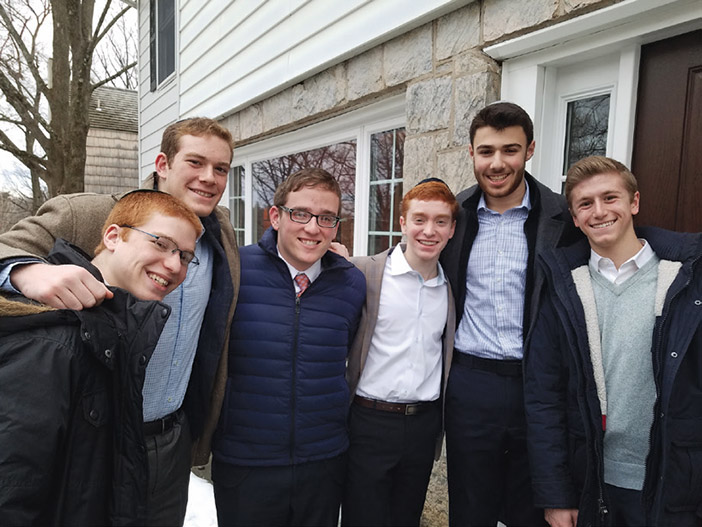
The second annual Jewish Center of Teaneck-Torah Academy of Bergen County Shabbaton took place this past Shabbat, Tzav-HaGadol.
Friday night davening at Jewish Center of Teaneck was beautifully led by Avrumi Davis (‘19), with the Dvar Torah being delivered by fellow junior Jonathan Haberman. Jonathan developed the mitzvot of terumat ha-deshen and hotza’at ha-deshen, and, in particular, a passage in the Sifra which can be applied to the significance of having special clothing for Shabbat.
The Friday night meal was shared by congregants from The Jewish Center and students from TABC. At this meal, Eli Rifkind (‘19), argued that the prohibition in Parshat Tzav to extinguish the flame from the altar was in fact a metaphor for the flame within the Jewish soul.
Following the Friday night meal, TABC rebbe Rabbi Nachbar explored one of his favorite topics in halacha, the korban mincha. Rabbi Nachbar’s treatment of the mincha as a perfectly calibrated balance between an expression of human creativity and humility, as expressed by the issur chametz which governs the korban mincha, as well as the obligation of petitah prior to the offering of the flour, was a masterful synthesis of the themes of the parsha and Pesach.
Talmidim shared chidushei Torah into the wee hours of the night, with many seniors sharing deeply moving reflections on their high school years. The manner in which the talmidim built upon each other’s chiddushim, and brought further insights and applications of new concepts being developed, was profoundly moving. Avi Roth (‘18) expressed the sentiment shared by all, that this was a fulfillment of Chazal’s expression (Brachot 6b) “Agra D’Chalah Duchka;” that the reward for coming to learn in advance of Yom Tov could be felt in the closeness and intimacy of the oneg environment.
On Shabbat morning, Shmuel Ross (‘18) delivered Rabbi Fridman’s Rabbi Solomon and Bella Gopin Memorial Rambam shiur. Ross developed a seeming anomaly between Rambam’s requirement of kavana in the mitzvah of shofar, as opposed to the mitzvah of achilat matzah. After presenting the classic resolution of the Ran, which argues that kavana plays a less central role in achilat matzah due its physical benefit, hana’ah, Ross developed his own original chiddush in Rambam’s view, arguing the preparation one does in advance of achilat matzah, and in particular, abstaining from matzah on erev Pesach, constitutes a de facto kavana which is then in place, even if one does not have kavana at the time of the consumption of matzah. This was a highly original approach, and is sure to stir much further debate.
Alexander Ostin (‘19) introduced parshat Tzav with the Ramban’s stirring defense of the practice of korbanot, contra Rambam’s view in the Moreh Nevuchim which presents korbanot as a concession to the pagan habits of the ancient world, noting the importance of purging ourselves of various primal instincts.
Yaakov Zinberg (‘18) introduced the special haftarah of Shabbat HaGadol by beautifully noting that Malachi’s indictment of religious apathy is a perfectly timed message for Chag HaMatzot, which requires alacrity, intensity and focus. Zinberg noted the clear contingency established by the final two verses of the haftarah, in which the final redemption, pre-saged by the arrival of Eliyahu HaNavi, depends upon the Jewish people’s fidelity to mitzvot, Zichru Torat Moshe Avdi. A special thank you to Tani Greengart (‘18) and Yehoshua Kanarek (‘19) for so capably leading Shacharit and Mussaf, respectively.
Shabbat lunch, shared by JCOT congregants and TABC talmidim, featured a Dvar Torah by Yonatan Sturm (‘18), who skillfully developed a common denominator between the parsha, haftarah and the upcoming Chag.
On Shabbat afternoon, talmidim did preparation of the mekorot for Rabbi Fridman’s Shabbat HaGadol drasha, which focused on the dialectic of Leil HaSeder being, at once, completely distinct from the rest of the year, and yet, meant to impact the rest of the year. Two examples of this phenomenon could be discerned in the exportation of the halacha of bikkur daled yamim from Korban Pesach to the Korban Tamid (Pesachim 96a), as well as the transmutation of the mitzvah of Sippur Yetziat Mitzraim into Zechirat Yetzitat Mitzraim.
The shabbaton concluded with a most meaningful seudah shlishit, in which Shlomi Helfgot magnificently developed themes from the first chapter of Rambam’s Hilchot Bi’at Mikdash. Developing two particular halachot in that perek, Helfgot compellingly argued that Rambam’s view that the kohen is compelled to live an existence in which one must constantly be poised for the opportunity to engage with Shechinah, and subsequently, to be transformed by that experience, in light of the equivalent standing of din ha-yotzeh and din ha-nichnas.
In many respects, Helfgot’s Dvar Torah was an apropos coda to a shabaton that was suffused with tefillah, talmud Torah chidushei Torah of the talmidim. In their profound creativity in learning, the TABC talmidim uplifted the Jewish Center of Teaneck community for Shabbat, which eagerly awaits next year’s shabbaton.
By Rabbi Daniel Fridman













